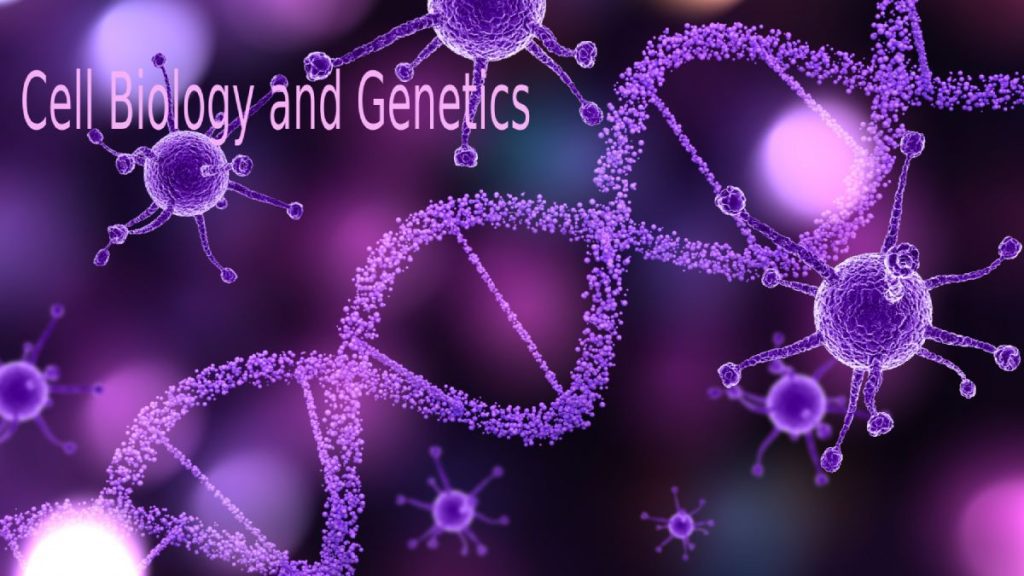Introduction to Cell Biology
Cell biology is the study of the structure, function, and behavior of cells—the basic unit of life. Every living organism, from the smallest bacteria to the largest mammals, is composed of cells. These tiny units perform the essential processes that allow life to exist and thrive. Cell biology is a fundamental discipline in the biological sciences, exploring how cells operate individually and in groups, forming the tissues, organs, and systems of the body.
Table of Contents
ToggleIn this topic, we’ll dive deeper into the core aspects of cell biology and genetics, showing how they are interlinked and essential for understanding both basic life processes and complex diseases.
The Structure of a Cell
A typical cell can be broadly divided into two categories: prokaryotic (found in bacteria and archaea) and eukaryotic (found in plants, animals, fungi, and protists).
- Prokaryotic Cells: These are simpler cells without a defined nucleus. Their genetic material floats freely in the cytoplasm. Despite their simplicity, prokaryotic cells carry out all essential life processes.
- Eukaryotic Cells: Eukaryotic cells are more complex and are characterized by a membrane-bound nucleus that houses the genetic material. These cells also contain other organelles, such as mitochondria (the powerhouse of the cell), endoplasmic reticulum (involved in protein and lipid synthesis), and Golgi apparatus (modifies, sorts, and packages proteins).
Key Functions of Cells
Cells are responsible for numerous life processes, including:
- Energy Production: Cells extract energy from nutrients through processes like cellular respiration and photosynthesis (in plants).
- Protein Synthesis: Ribosomes in cells synthesize proteins, which are vital for cell structure, enzymes, and communication.
- Cell Division: Cells replicate themselves through processes like mitosis (for growth and repair) and meiosis (for reproduction).
- Transport: Cells regulate the movement of substances in and out through the plasma membrane, maintaining homeostasis.
Introduction to Genetics
Genetics is the branch of biology that studies genes, genetic variation, and heredity in living organisms. While cell biology focuses on how individual cells function, genetics delves into the blueprint that drives these cellular processes.
Genes are sections of DNA (deoxyribonucleic acid) that carry the instructions for building and maintaining an organism. They are the fundamental units of heredity, passed from one generation to the next. Each gene encodes for a specific protein, which carries out various functions within the cell and organism.
The Role of DNA
At the heart of genetics lies DNA, a molecule composed of two long strands forming a double helix. Each strand consists of nucleotides, which include a phosphate group, a sugar molecule, and one of four nitrogenous bases:
- Adenine (A)
- Thymine (T)
- Cytosine (C)
- Guanine (G)
The sequence of these bases determines the genetic code, which cells read to synthesize proteins.
Genetic Processes
- DNA Replication: Before a cell divides, its DNA must be replicated to ensure that each daughter cell receives an exact copy of the genetic material.
- Transcription and Translation:
- Transcription: In the nucleus, a segment of DNA is transcribed into mRNA (messenger RNA).
- Translation: This mRNA travels to the ribosome, where it is translated into a specific protein, following the instructions encoded in the gene.
- Mutations: Changes in the DNA sequence, called mutations, can lead to variations in proteins, which may cause diseases like cancer or drive evolution by introducing new traits.
Genetics and Heredity
Heredity is the process by which traits are passed from parents to offspring through genes. Each individual inherits two sets of chromosomes, one from each parent. Humans, for example, have 23 pairs of chromosomes (46 in total), which contain thousands of genes.
- Dominant and Recessive Traits: Some traits are determined by dominant genes, while others are determined by recessive genes. If an individual has both a dominant and a recessive gene for a trait, the dominant gene will typically be expressed.
- Genetic Variation: Genetic variation arises from differences in DNA sequences between individuals. This variation can be due to mutations, gene recombination during meiosis, or random genetic drift.
Cell Biology and Genetics in Health and Disease
Both cell biology and genetics play critical roles in understanding diseases, especially genetic disorders and cancers.
- Genetic Disorders: Diseases like cystic fibrosis, sickle cell anemia, and Huntington’s disease are caused by mutations in specific genes. By studying the genetics of these diseases, researchers can develop targeted therapies.
- Cancer: Cancer arises when cells lose control over their division, often due to mutations in genes that regulate the cell cycle. Understanding the genetic basis of cancer helps in the development of treatments like chemotherapy, radiation, and immunotherapy.
- Stem Cells: Stem cells have the potential to develop into any cell type, making them a crucial focus of research in regenerative medicine. Understanding how stem cells differentiate into various cell types is essential for developing treatments for a range of diseases, including neurodegenerative conditions and injuries.
Emerging Fields in Cell Biology and Genetics
The integration of cell biology and genetics has led to several exciting developments in biotechnology and medicine:
- CRISPR-Cas9: This gene-editing tool allows scientists to alter DNA sequences and potentially correct genetic disorders. It holds immense promise for treating diseases at the genetic level.
- Gene Therapy: Gene therapy involves inserting, altering, or removing genes within an individual’s cells to treat diseases. This approach has been successfully used to treat some blindness and blood disorders.
- Personalized Medicine: By understanding a patient’s genetic makeup, doctors can tailor treatments to the individual, leading to more effective therapies with fewer side effects.
Conclusion
Cell biology and genetics are intricately connected fields that provide profound insights into the mechanisms of life. Understanding how cells function and how genetic information is passed down helps scientists decode the mysteries of biology, paving the way for innovations in healthcare, agriculture, and biotechnology. As research in these fields advances, we are on the cusp of transformative breakthroughs that will change the future of medicine and human health.





